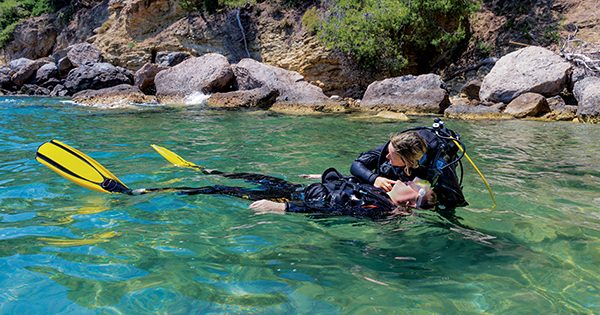WHEN ASKED TO DESCRIBE THEIR FAVORITE COURSE, many divers will discuss the challenges and triumphs they experienced during their rescue class. Instructors often describe rescue as the most rewarding course they teach. It is often the first course in which divers begin thinking about others more than themselves, so it’s little surprise that it stands out.
Every certified rescue diver’s primary goal should be to go home at the end of the day. A comprehensive rescue course teaches students how to handle common and rare emergencies. Most courses consist of classroom, confined-water, and open-water sessions where instructors introduce skills and students practice. Rescue skills include identifying minor problems before they escalate, self-rescue techniques, recovering an unresponsive diver, and dealing with a panicked diver. Some rescue courses include instructor-instigated issues such as a broken fin strap, zero visibility entanglement, or out-of-gas situations. Sometimes those scenarios are used as a rite of passage rather than teaching and learning moments.
REGULAR PRACTICE
When was the last time you practiced rescue skills? For many divers, it was only during their rescue course, whether that was six months or six years ago. By the time recreational divers join the professional ranks, they have probably successfully cleared their masks hundreds, if not thousands, of times. Rescue skills, however, have far fewer repetitions. Divemaster and instructor training require demonstrating rescue skills, but how often have divers practiced them, let alone used them in an actual rescue? This question is not about doing routine, simple things to assist a buddy, like removing a piece of monofilament line from their tank valve, but rather an actual rescue involving an unresponsive or panicked diver.
Most dive professionals haven’t had to use their rescue skills outside of a training environment. Obviously, we can’t plan for real-life rescues, and divers do not know what it is like to respond to an emergency until one happens. To effectively utilize them in an emergency, divers should regularly practice rescue skills — as should anyone who wants to teach them.
TEACHING QUALIFICATIONS
What qualifies an instructor to teach a rescue course is not raised often enough in the dive industry. Is it having taken a rescue diver course once, or should the qualifications be more extensive?
Despite the lack of standardized requirements, instructors should challenge their skills by enrolling in continuing education. It’s worthwhile to take a rescue course again with a different instructor and perhaps a different agency or, even better, to take an advanced rescue course. An advanced course will be a good refresher and offer knowledge and additional techniques that your initial course didn’t cover.

Diver checks casualty for breathing during a rescue practice
A well-rounded instructor may even consider enrolling in a diver survival or a lifeguarding course to build situational awareness, authoritative communication, and emergency preparedness skills. Extracurricular classes ensure an instructor has the expertise to teach rescue students and that they are relying on current skills rather than what they learned in their rescue course.
Aside from enrolling in a course, what can dive professionals do right now to ensure they teach the best possible rescue course? There is no substitute for routine practice. When preparing for a dive, look for gear issues to address for yourself, your buddy, and other nearby divers. Practice fundamental dive and rescue skills regularly. Grab a buddy and practice recovering an unresponsive diver, towing them to shore, and getting them out of the water. On a safety stop, review skills such as air sharing or mask clearing. Take time to practice panicked diver scenarios.
As instructors prepare to teach a rescue course, they should assess their skills honestly and determine if they are qualified to instruct students. If you can identify areas of deficiency, plan to resolve them. You can work on physical conditioning if that would improve your ability to perform skills. If you need to increase your knowledge, find resources to study. If it has been a while since you have practiced your skills, get in the pool. It is okay to acknowledge your areas of weakness to your students, as you can set an example of how important it is to recognize them and improve.
COURSE CONTENT
What does a good rescue course contain? It should start by building upon the fundamental skills that divers learn in open-water and advanced open-water courses, such as mask removal and replacement, proper trim and buoyancy, regulator recovery, and buddy procedures.
Specific skills that divers should efficiently grasp during their rescue course include identifying issues before they become emergencies, configuring gear for optimal use, approaching an unresponsive or panicking diver, and managing their own safety while caring for other divers. The course should also cover multiple techniques for dealing with a panicked diver, preventing a diver from bolting, and managing an injured diver on the surface.
Instructors owe it to their students to prepare them to the best of their ability. To make sure that happens, sufficient qualifications, practice, and experience beyond an introductory rescue course from recreational certification are invaluable. Remember, the rescue diver’s primary goal is to go home at the end of the day. Be sure you and your students have proper training and practice often to make that goal as likely as possible.
Alert Diver — Q3 2022